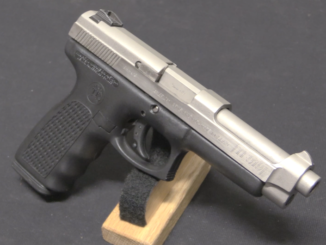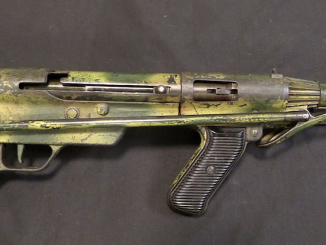In 1943, experimentation began in Great Britain, Canada, and Australia into developing a shortened and lightened version of the Lee Enfield rifle. In Australia, the work was done on the No1 Mk3* rifle, as the Lithgow Arsenal had never switched over to production of the No4 rifle.
We have three experimental prototype carbines from Lithgow to look at today. The first is simply a shortened SMLE, with no serious effort given to reducing weight. This rifle is visually very similar to the commercial SMLE “Jungle Carbines” marketed by a number of companies, although the real one here has several features missing form the commercial copies – most notably a simple rear aperture sight.
The other two are examples of the two types of rifle that were ultimately considered for formal adoption (and a large order for one was actually placed, before being cancelled at the end of WW2). These are designated the No6 Mk1 (with a rear aperture sight) and the No6 Mk1/1 (with a rear tangent sight). Approximately 100 of each were made, half with brass buttplates and half with rubber recoil pads. In this form, slightly more than a pound was removed from the standard SMLE, and the reduced length did make for a handier rifle. The Australian need for this type of carbine was removed with the end of the war, although in Great Britain the No5 Mk1 carbine – the same in practical terms as these Australian examples – would be taken into formal service for several years.




Kind of funny that they left those thick ass sights instead of milling off their backs.
The simplified apperature sight seams the most practical of the lot. The best option for them at that point in time might have been “buying” a few hundred thousand US M1Carbines for jungle terrain. Build a section around the Bren LMG, one or two designated riflemen with SMLEs, and the balance armed with carbines. Including Grenadiers, the carbine could cycle without modification with the grenade throwing ammunition.
Adrian Treefalls excellent ‘Jungle Warriors’ briefly covers the stalled development for the Mk6 (bunch of WW1 generals who didn’t have a clue insisting the Mk3 was good enough… Blamey ) and discusses the composition of the standard 2nd AIF infantry section towards the end of the war consisting of one Bren, one Mk3 wired up for launching grenades and everyone else with an Owen, so in some respects the Mk6 was already redundant from a doctrinal perspective. Also lost in the mix was that the planned invasion of Japan was well developed, with MacArthur insisting on singular US Sourced weapons from a logistics simplification perspective, namely the M1, further relegating the need for a shortened SMLE.
But what of paratroopers? Australia only had one parachute battalion and although it wasn’t deployed due to lack of planes, this unit was armed with, wait for it, the Austen SMG. (Not the far more popular Owen, the flooding stock suited the splatcats better and as an aside, was also preferred by Z special unit commandos in the surpressed guise)
BUT WAIT:It gets more convoluted, there does exist a 303 caliber M1 Garand prototype last seen at the School of Infantry museum. Information is non-existent, but the suspicion was that in line with MacArthurs edict on M1 for the Japanese bloodbath, I mean invasion, someone thought it prudent to at least try and develop a version in the commonwealth standard 303 British caliber.
Are you casting aspersions on the provenance of my Authentic Republic of Texas Delta Force Marine M16AA4 in 6.5x50mm Arisaka?
Why not just design a semiautomatic (or select-fire) jungle carbine based on the Farquhar-Hill!?
Ian,
Do you think that the foresight protectors could be from the Bren gun?
I wouldn’t to get that shortened SMLE. Nifty carbine, with that simple rear aperture sight. Lithgow made some of the best SMLEs, with above average fit and finish.